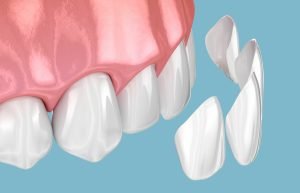Composite bonding is a cosmetic dental procedure that involves applying a tooth-coloured composite resin material to the teeth to improve their appearance. The procedure is non-invasive and can be done in a single visit to the dentist in Hawick office. In this article, we will explore the basics of composite bonding, its benefits, and how it works at GK Dental Hawick.
What is Composite Bonding?
Composite bonding is a cosmetic dental procedure that involves applying a tooth-coloured composite resin material to the teeth to improve their appearance. The composite resin material is a mixture of plastic and glass that is customised to match the colour of the patient’s teeth.
Composite bonding can be used to fix a variety of cosmetic dental issues, including chipped or broken teeth, gaps between teeth, discoloured teeth, and misshapen teeth. It is also used as a dental filling material for cavities.
Benefits of Composite Bonding in GK Dental Hawick
Composite bonding has several benefits, including:
Non-invasive
Composite bonding is a non-invasive dental procedure, meaning that it does not require the removal of healthy tooth structure, unlike other cosmetic dental procedures.
Quick procedure
Composite bonding is a relatively quick procedure that can be completed in a single visit to the dentist’s office.
Cost-effective
Composite bonding is a cost-effective cosmetic dental procedure compared to other cosmetic dental procedures such as dental veneers or dental crowns.
Versatile
Composite bonding can be used to fix a variety of cosmetic dental issues, including chipped or broken teeth, gaps between teeth, discoloured teeth, and misshapen teeth.
How Does Composite Bonding Work at GK Dental Hawick?
At GK Dental Hawick, the composite bonding procedure involves the following steps:
Step 1: Consultation and Examination
The first step in the composite bonding procedure is a consultation and examination with one of our dental professionals. During this step, the dentist will evaluate the patient’s teeth and determine if composite bonding is the best solution for their cosmetic dental issue. The dentist will also discuss the procedure and the expected results and answer any questions that the patient may have.
Step 2: Preparation
Once the patient has decided to proceed with composite bonding, the dentist will prepare the teeth by cleaning and lightly roughening the surface of the teeth to help the composite resin material adhere better. The dentist may also apply a conditioning liquid to the teeth to help the composite resin material bond to the teeth better.
Step 3: Application of Composite Resin Material
After the teeth are prepared, the dentist will apply the composite resin material to the teeth. The dentist will shape and mould the composite resin material to the desired shape and size. Once the composite resin material is in place, the dentist will use a special light to harden the material.
Step 4: Shaping and Polishing
After the composite resin material has hardened, the dentist will shape and polish the material to give it a natural appearance and a smooth surface. The dentist may also adjust the colour of the composite resin material to match the patient’s natural teeth.
Step 5: Final Check and Post-Operative Care
Once the composite bonding procedure is complete, the dentist will conduct a final check to ensure that the patient’s teeth look and function as desired. The dentist will also provide post-operative care instructions to help the patient maintain their new smile.
Composite Bonding vs. Other Cosmetic Dental Procedures
Composite bonding is not the only cosmetic dental procedure available at GK Dental Hawick. Other cosmetic dental procedures include dental veneers and dental crowns. Here’s how composite bonding compares to these other cosmetic dental procedures:
Composite Bonding vs. Dental Veneers
Dental veneers are thin, custom-made shells that are placed on the front surface of the teeth to improve their appearance. Like composite bonding, dental veneers are used to fix a variety of cosmetic dental issues, such as chipped, cracked, or discoloured teeth. However, unlike composite bonding, dental veneers require the removal of a small amount of tooth structure to accommodate the veneers. The process of getting dental veneers also typically takes longer than composite bonding and may require multiple visits to the dentist. Dental veneers are also typically more expensive than composite bonding.
Composite Bonding vs. Dental Crowns
Dental crowns are tooth-shaped caps that are placed over damaged teeth to restore their shape, size, and strength. Dental crowns are typically used for more severe cosmetic dental issues such as severe tooth decay or a broken tooth. Unlike composite bonding, dental crowns require the removal of a significant amount of tooth structure to accommodate the crown. The process of getting a dental crown also typically takes longer than composite bonding and may require multiple visits to the dentist. Dental crowns are also typically more expensive than composite bonding.
Conclusion
In summary, composite bonding is a versatile, cost-effective, and non-invasive cosmetic dental procedure that can be used to fix a variety of cosmetic dental issues. At GK Dental Hawick, the composite bonding procedure is a relatively quick and straightforward process that can be completed in a single visit to the dentist’s office. If you are interested in composite bonding or any other cosmetic dental procedure, it’s best to consult with a dental professional to determine the best solution for your individual needs.





